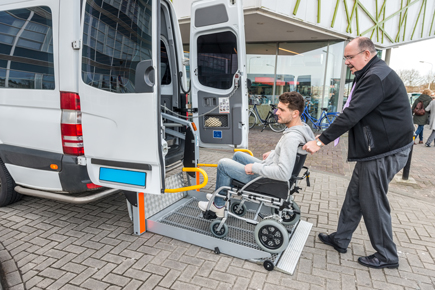One of the predicted benefits of self-driving vehicles (SDVs) is improved mobility and access for those unable to drive. The extent to which this happens, however, will depend not just on marketplace competition, but also on public policy decisions that ensure an equitable transportation system.
This is the conclusion of a new analysis by Frank Douma, director of the State and Local Policy Program (SLPP) at the Humphrey School of Public Affairs; Adeel Lari, director of innovative financing at SLPP; and Kory Andersen, graduate student in urban and regional planning. The research was conducted under the Transportation Policy and Economic Competitiveness Program, which is led by SLPP.
“The benefits of self-driving vehicles for the disadvantaged won’t happen automatically,” Douma says. “For example, just because a self-driving vehicle can transport a person that is physically unable to drive, it doesn’t mean that the person will be able to easily enter and exit the vehicle, nor easily interact with it, unless the vehicle has been specifically designed to meet the needs of these users.”
The development of self-driving cars is fast-paced and proprietary, Douma adds, and it’s unclear what physical form and design elements SDVs will have. Cognitive and other disabilities also pose challenges that need to be considered.
Although accessible prototypes have been developed, deployment is uncertain. The researchers suggest that tax incentives could be created to prompt vehicle manufacturers to further develop and promote SDVs to serve people with disabilities.
Another challenge to making SDVs benefit all people is keeping the costs affordable. Manufacturing costs are still relatively high, mostly because of SDV safety technology. “If SDVs enter the market as available for private purchase, only the most well-off individuals would reap the safety and mobility benefits,” Douma says.
This private ownership model also assumes that individuals would absorb the costs that public transit agencies currently incur for on-demand paratransit services. The per-trip costs of these services are often three or more times those of fixed-route transit services. “If disabled individuals can transport themselves, public services and costs could be greatly reduced,” Andersen says.
An alternative, the researchers say, is moving toward a model in which fleets of SDVs function as a circulatory system for the population at large, providing mobility benefits to more people at lower costs. “The fleet model eliminates any large up-front cost barriers,” Lari says. “Instead, individuals pay by trip, which makes it easier to budget.” Discounted payment rates could be offered to disabled individuals and seniors.
However, without policy changes, “it is not clear if there are incentives for car manufacturers to develop SDVs for anything other than private ownership,” Douma says. To encourage development of an SDV fleet system, states could reform existing legislation or enact new policy. Minnesota, for example, could consider reducing or eliminating its sales tax on car-sharing services, he says.




